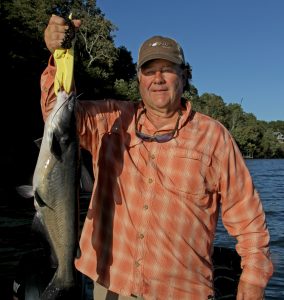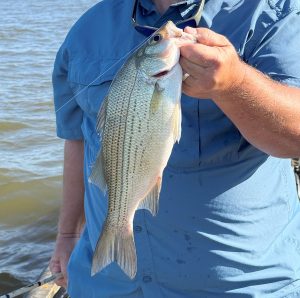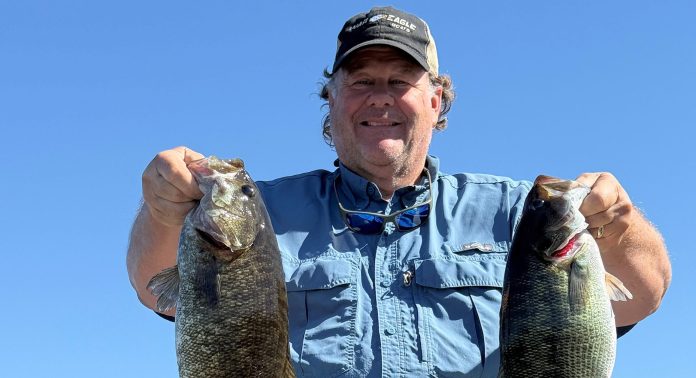TUSCUMBIA — What do you do after you plan a trip to north Alabama to get in the fall crappie bite and you’re greeted with bluebird skies the day after a cold front?
You make lemonade, and the Tennessee River lakes have just the right recipes.
Capt. Brian Barton, Andy Poss and I still wanted to try to catch enough crappie for a small fish fry and headed into the Bear Creek area despite the weather conditions. We found crappie on the forward-facing sonar, but almost all of them had the lockjaw, a common occurrence after a front. We tried small jigs with a minnow, jigs alone and minnows alone, but the crappie just ignored any of the offerings.

The great thing about fishing those lakes, especially Wheeler, Wilson and Pickwick, is the availability of fishing tailraces for anything that will bite a live shad, either a small gizzard shad or threadfin.
After loading Barton’s 23-foot War Eagle boat onto the trailer, we found gizzard shad flicking near the boat ramp on Wheeler. We headed to the Wheeler tailrace with a bait tank filled with the 2- to 3-inch shad. Obviously, as anyone who has fished the tailraces knows, the most productive time to fish is when the generators are running and the water is flowing through the dams.
As required by law, we had donned our life jackets before approaching the dam and headed to the edge of the swift current. Drifting a shad down the edge of the current line with just a split shot started producing action. However, you don’t get to choose the species. You set the hook and take what you get. It may be bass species, catfish species or freshwater drum (known as gaspergou in Louisiana).
Because we tried to catch crappie first, we were a little late to the bite at the Wheeler tailrace due to the generation schedule, which had shifted from afternoon to morning because of the cool nights.
The next morning, we headed to the Wilson tailrace, which doesn’t have quite the dramatic water flow of Wheeler but is still a highly productive fishing spot. The tactics were similar, finding edges to let the bait drift with the current.
By the end of the tailrace fishing, we had caught catfish (blue, channel and flathead), bass (smallmouth, largemouth, spotted and white) and enough drum to fill a roadside trash can.
“In the fall up here, from the end of September all the way until Christmas, shad migrate to the dams, and everything else follows,” Barton said. “You have multi-species action for about three months, solid. When I have clients, I catch bait before I pick them up, and then we go to the tailraces. We may drift, anchor or Spot-Lock (trolling motor feature using GPS to stay in one location) in different areas, but it will always be with a live shad.”

Barton said the Tennessee Valley Authority (TVA) controls how and when he fishes because the agency’s electricity generation dictates current flow.
“The stronger the current, the more the fish are going to be pulled out into the river,” he said. “With a lighter current, the fish are going to be more spread out and harder to catch. Also, the bright sunny days means the fish tend to stick close to structure. On cloudy days, they are more spread out. Ideally, the best day would be good current flow with sunshine.”
Barton said TVA has an app (www.tva.com/environment/lake-
“It (the projections) doesn’t change much,” he said. “But on our trip, you saw it change. It had been afternoon generation. Then we got a cold front with cooler nights, and it changed to morning generation. From now until March or April, it will stay mornings. As it warms up next spring, it’ll flip back to afternoons.
“Ideal current flow below Wheeler Dam would be 30,000 to 50,000 (cubic feet per second), and below Wilson it would be 30,000. Wheeler can generate up to 98,000. If you start getting over 50,000, which is great current, you just go down the river because it’s too tough to battle it near the tailrace. But that really turns the fishing on down the river, where if you’ve got 25,000 or 30,000, you’re pretty much forced to fish closer to the dam because you don’t have enough current down river to position the fish.
“But I want to caution people to not go to that dam unless you know what you’re doing, and, by all means, wear that life vest.”
When he’s fishing with live bait, he’s looking for two different locations where the fish are likely to hold to be able to ambush anything coming out of the tailrace.
“There’s two theories,” Barton said. “There’s site specific fishing on rockpiles, ledges or wood. Most of the time, I do better just drifting. My theory is I go to the spot where I caught them the last trip. That doesn’t always work because the fish move, but I start there first. If I start a drift in 12 feet of water and don’t do any good, then I’ll move up to 8 or 9 feet or I’ll go to 14 or 15. That’s all I do is move my depth. It’s just a matter of if they’ve moved deep or shallow.
“When you’re fishing the tailrace, it’s all about seams. I don’t think bottom structure has anything to do with it. It’s where two currents meet and create a seam or the outside edge of the current. But that’s not just the tailrace. Anywhere you go down the river that has an abutment or anything sticking out can create a current change. That structure may be the size of my garage, and it’s going to create that seam. That’s where the fish are going to be most of the time.”
Barton said when clients ask about a fishing trip, he tells them to expect to catch multiple species of fish in a five-hour trip.
“It could include a miscellaneous sauger or skipjack (herring), but seven species is what two people in this boat are normally going to catch,” he said. “With good conditions, I expect to catch 40 to 50 fish in a five-hour trip. Now, that’s not a great day. That’s just what I expect to catch. And, if you’re lucky, you can catch a four-pound smallmouth. That’s very doable. A five-pound smallmouth is what we call a trophy fish. If I have people who just want to catch smallmouth, that’s what they’re looking for.
“Most of my clients are just people who want a bent rod and to have fun. If they catch a four-pound smallmouth, that’s just a bonus. Most people just want to catch fish, and that’s why I like to call it a multi-species fishing trip.”
Visit www.brianbartonoutdoors.com or call 256-412-0969 for information about fishing on the Tennessee River. Other than the multi-species trips, Barton also does seasonal fishing that targets species like catfish, crappie and bream, both bluegills and shellcrackers (redear sunfish).
When you’re in northwest Alabama, don’t forget about the lodging available at Joe Wheeler State Park, which sits on the banks of the Tennessee River near Rogersville. Joe Wheeler has perfect accommodations for anglers, including the cabins away from the main lodge. The cabins are located on the south side of the Tennessee River near Wheeler Dam. This area has accessibility to Wheeler and Wilson lakes.
A boat launch for Wheeler Lake is available in the cabin area, and another boat launch is located across Highway 101 at Wheeler Dam for Wilson Lake access. Visit www.alapark.com/parks/joe-
After your fishing trip, Colbert County has an abundance of places to visit, including the Helen Keller home, Fame Recording Studios, Muscle Shoals Sound, the Alabama Music Hall of Fame and the Coon Dog Cemetery. Visit www.colbertcountytourism.org/
Don’t miss out! Subscribe to our email newsletter to have all our smart stories delivered to your inbox.



